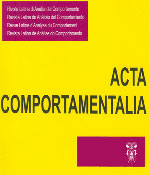Operant Behavioral Variability and the Lag–N Schedule of Reinforcement
DOI:
https://doi.org/10.32870/ac.v18i2.27991Keywords:
behavioral variability, operant variability, operant behavior, Lag–N schedule, behavioral sequencesAbstract
There are two groups of studies that investigated variability of responding. One group includes the studies that investigated the behavioral variability without reinforcing it differentially. Another group of studies investigated the behavioral variability generated by differential reinforcement. According to some researchers, studies of later group produced data showing that variability is an operant dimension of behavior. So there would be an operant variability. The present study analyses the pertinence of such point of view. Controlling by consequences is the basic feature of operant behavior. Some authors that examined the concept of operant distinguished two classes of behavior: the class of behavior that produces consequences (descriptive class) and the class of behavior that is affected by consequences produced (functional class). The present work adopted this perspective. The relationship between both classes, measured by the standard correlation coefficient (r), defines operant behavior. The differential reinforcement usually changes the correlation coefficient between classes over the time. Positive variation of r represents the differentiation process. Descriptive classes are defined upon some parameter of behavior (like force, duration, location and so on). Such parameters were called primary parameters. It is possible define, upon such primary parameter, a secondary parameter, the recurrence time parameter (RT), that reflects the recency of a certain value of the primary parameter. Lag–N schedule defines descriptive classes upon the secondary parameter RT. Many studies of operant behavioral variability employed Lag–N schedules and reinforced differentially response sequences. Responses on two manipulanda (left manipulandum and right manipulandum) composed sequences of R and L components. Such studies took behavioral variability as synonym of unpredicability and chose as main dependent variable the U measure, a value that reflects predicability of events. From this point of view, variable responding is responding with low predicability level. The studies show that Lag–N schedule increases the U values (when the values are compared with the baseline U values). However, because Lag–N schedule does not define descriptive class upon the U values, it is not possible measure the variation of correlation upon U. Moreover, the U represents a property of a population of events (responses or sequences). It does not reflect the property of an unique response or sequence. Defining a descriptive class upon the U measure might be conceptually problematic. The traditional employment of U takes into account frequencies at which different sequences are emitted. The present work argues that this procedure represents an arbitrary choice. The determination of U can take into account other universes of events and distribution of other variables. The same behavioral pattern can be said to be highly variable or lowly variable depending on the universe regarded for the calculation of U. The present study concludes that Lag–N schedule produces effects on behavior that do not concern the RT parameter. The variation of U is among these effects. Particularly, the variation of U does not represent the differentiation process that Lag–N schedule generates. This fact debilitates the point of view that variability is an operant dimension of behavior.Downloads
Download data is not yet available.
Downloads
How to Cite
de Souza Barba, L. (2011). Operant Behavioral Variability and the Lag–N Schedule of Reinforcement. Acta Comportamentalia, 18(2). https://doi.org/10.32870/ac.v18i2.27991
Issue
Section
Articles
License

<a rel="license" href="http://creativecommons.org/licenses/by-nc-sa/4.0/"><img alt="Licencia de Creative Commons" style="border-width:0" src="https://i.creativecommons.org/l/by-nc-sa/4.0/88x31.png" /></a><br />Este obra está bajo una <a rel="license" href="http://creativecommons.org/licenses/by-nc-sa/4.0/">licencia de Creative Commons Reconocimiento-NoComercial-CompartirIgual 4.0 Internacional</a>.






